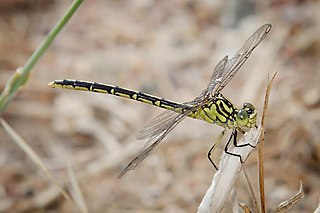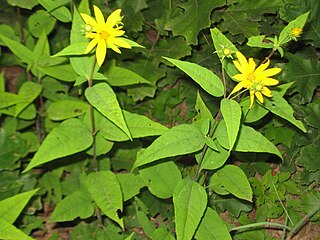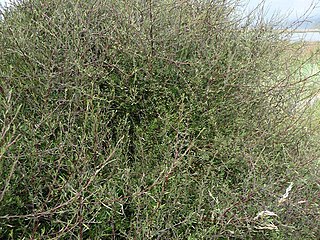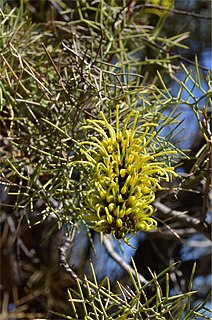
Chimmini Wildlife sanctuary is a protected area located along the Western Ghats in Chalakudy taluk of Thrissur District of Kerala state in India.

The ashy minivet is a passerine bird of eastern Asia belonging to the minivet genus Pericrocotus in the cuckooshrike family Campephagidae. While most of the minivets have shades of yellow, orange and red in their plumage, this species has only greys, whites and blacks. The male is distinctive with a white face and black nape although females can be confused with the female of the brown-rumped minivet. They forage in the canopy, often along with other minivets and join mixed-species foraging flocks.

Austrogomphus is a genus of dragonflies in the family Gomphidae, endemic to Australia. Species of Austrogomphus are tiny to medium-sized dragonflies, black in colour with yellowish markings. They are commonly known as hunters.

Helianthus divaricatus, commonly known as the rough sunflower, woodland sunflower, or rough woodland sunflower, is a North American species perennial herb in the composite family. It is native to central and eastern North America, from Ontario and Quebec in the north, south to Florida and Louisiana and west to Oklahoma and Iowa.

Adenocarpus is a genus of flowering plants in the legume family, Fabaceae. It belongs to the subfamily Faboideae. The plants are broom-like shrubs with bright yellow flowers. The genus is native to Macaronesia, Portugal and southern Spain, and three species are endemic to the western Canary islands where they are known by the common name Codeso.

Plagianthus divaricatus or saltmarsh ribbonwood is a plant that is endemic to New Zealand. The Māori name is makaka.
Iolaus parasilanus, the friendly sapphire, is a butterfly in the family Lycaenidae. It is found in Ghana, Nigeria, Gabon, the Republic of the Congo, Angola, the Democratic Republic of the Congo, Uganda, Kenya and Tanzania. The habitat consists of forests.

Strophanthus divaricatus is a liana or sarmentose shrub that can grow up to 4.5 metres (15 ft) tall, with a trunk diameter of up to 4 centimetres (1.6 in). Divaricatus is from the Latin meaning "spreading at a wide angle". The plant has been used medicinally: as a heart stimulant and in the treatment of snakebites. It is native to southern China and northern Vietnam.

Cyathostemon is a genus of flowering plants in the myrtle family, Myrtaceae. The genus is endemic to southwestern Western Australia. The genus was first described by Nikolai Turczaninow in 1852. Species include:

Hakea divaricata, commonly known as needlewood, corkbark tree or fork-leaved corkwood, is a tree or shrub in the family Proteaceae native to an area in central Australia. A slow growing species with up to 120 showy cream to greenish-yellow flowers in long racemes from June to November.

Austrogomphus divaricatus, also known as Austrogomphus (Pleiogomphus) divaricatus, is a species of dragonfly of the family Gomphidae, commonly known as the fork hunter. It inhabits streams and rivers in northern Queensland, Australia.

Cyathostemon ambiguus is a member of the family Myrtaceae endemic to Western Australia.

Cyathostemon blackettii is a member of the family Myrtaceae endemic to Western Australia.
Cyathostemon gracilis is a member of the family Myrtaceae endemic to Western Australia.

Cyathostemon heterantherus is a member of the family Myrtaceae endemic to Western Australia.
Cyathostemon tenuifolius is a member of the family Myrtaceae endemic to Western Australia.
Cyathostemon verrucosus is a member of the family Myrtaceae endemic to Western Australia.

Daviesia divaricata, common-name Marno, is a shrub in the family Fabaceae. It is endemic to Western Australia. It usually grows from 0.3–3 metres (1–10 ft) high. Bentham describes it as having no leaves, and having smooth, green, rigid stems which are circular in cross-section (terete), having grooved spines at their tips. Stems branch off from one another at a wide-angle, giving the species its name, divaricatus being the Latin for wide-spreading. Its orange pea flowers, with their yellow, brown, red and purple centres, are produced between June and November in the species' native range. It grows on sand, over both limestone and laterite, and is found on sandplains, rocky outcrops, and roadsides.

Ptilotus divaricatus is a grass-like plant in the Amaranthaceae family.














